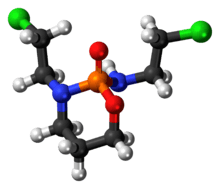Ifosfamide
Ifosfamide (IFO), sold under the brand name Ifex among others, is a chemotherapy medication used to treat a number of types of cancer.[1] This includes testicular cancer, soft tissue sarcoma, osteosarcoma, bladder cancer, small cell lung cancer, cervical cancer, and ovarian cancer.[1] It is administered by injection into a vein.[1]
-ifosfamide.svg.png) | |
 (R)-(+)- and (S)-(−)-ifosfamide (top), (S)-(−)-ifosfamide (bottom) | |
| Clinical data | |
|---|---|
| Pronunciation | /aɪˈfɒsfəmaɪd/ |
| Trade names | Ifex, others |
| Other names | 3-(2-chloroethyl)-2-[(2-chloroethyl)amino]tetrahydro-2H-1,3,2-oxazaphosphorine 2-oxide |
| AHFS/Drugs.com | Monograph |
| MedlinePlus | a695023 |
| Pregnancy category | |
| Routes of administration | intravenously |
| ATC code | |
| Legal status | |
| Legal status | |
| Pharmacokinetic data | |
| Bioavailability | 100% |
| Metabolism | Hepatic |
| Elimination half-life | 60–80% in 72 hours |
| Excretion | Renal |
| Identifiers | |
| |
| CAS Number | |
| PubChem CID | |
| IUPHAR/BPS | |
| DrugBank | |
| ChemSpider | |
| UNII | |
| KEGG | |
| ChEBI | |
| ChEMBL | |
| CompTox Dashboard (EPA) | |
| ECHA InfoCard | 100.021.126 |
| Chemical and physical data | |
| Formula | C7H15Cl2N2O2P |
| Molar mass | 261.08 g·mol−1 |
| 3D model (JSmol) | |
| |
| |
| (verify) | |
Common side effects include hair loss, vomiting, blood in the urine, infections, and kidney problems.[1] Other severe side effects include bone marrow suppression and decreased level of consciousness.[1] Use during pregnancy will likely result in harm to the baby.[1] Ifosfamide is in the alkylating agent and nitrogen mustard family of medications.[1][2] It works by disrupting the duplication of DNA and the creation of RNA.[1]
Ifosfamide was approved for medical use in the United States in 1987.[1] It is on the World Health Organization's List of Essential Medicines.[3]
Medical uses
It is given as a treatment for a variety of cancers, including:
- Testicular cancer
- Breast cancer
- Lymphoma (Hodgkin and non-Hodgkin)
- Soft tissue sarcoma
- Osteosarcoma or bone tumor
- Lung cancer
- Cervical cancer
- Ovarian cancer
Administration
It is a white powder which, when prepared for use in chemotherapy, becomes a clear, colorless fluid. The delivery is intravenous.
Ifosfamide is often used in conjunction with mesna to avoid internal bleeding in the patient, in particular hemorrhagic cystitis.
Ifosfamide is given quickly, and in some cases can be given as quickly as an hour.
Side effects
Hemorrhagic cystitis is rare when ifosfamide is given with mesna. A common and dose-limiting side effect is encephalopathy (brain dysfunction).[4] It occurs in some form in up to 50% of people receiving the agent. The reaction is probably mediated by chloroacetaldehyde, one of the breakdown products of the ifosfamide molecule, which has chemical properties similar to acetaldehyde and chloral hydrate. The symptoms of ifosfamide encephalopathy can range from mild (difficulty concentrating, fatigue), to moderate (delirium, psychosis), to severe (nonconvulsive status epilepticus or coma). In children, this can interfere with neurological development. Apart from the brain, ifosfamide can also affect peripheral nerves. The severity of the reaction can be classified according to either the National Cancer Institute or the Meanwell criteria (grade I–IV). Previous brain problems and low levels of albumin in the blood increase the likelihood of ifosfamide encephalopathy. In most cases, the reaction resolves spontaneously within 72 hours. If it develops during an infusion of the drug, discontinuing the infusion is advised. The most effective treatment for severe (grade III–IV) encephalopathy is an intravenous solution of methylene blue, which appears to shorten the duration of encephalopathy; the exact mechanism of action of methylene blue is unclear. In some cases, methylene blue may be used as a prophylaxis before further doses of ifosfamide are administered. Other treatments include albumin and thiamine, and dialysis as a rescue modality.[4]
Ifosfamide may also cause a normal anion gap acidosis, specifically renal tubular acidosis type 2.[5]
References
- "Ifosfamide". The American Society of Health-System Pharmacists. Archived from the original on 7 May 2017. Retrieved 8 December 2016.
- Dowd, Frank J.; Johnson, Bart; Mariotti, Angelo (2016). Pharmacology and Therapeutics for Dentistry (7 ed.). Elsevier Health Sciences. p. 533. ISBN 9780323445955. Archived from the original on 2017-09-11.
- World Health Organization (2019). World Health Organization model list of essential medicines: 21st list 2019. Geneva: World Health Organization. hdl:10665/325771. WHO/MVP/EMP/IAU/2019.06. License: CC BY-NC-SA 3.0 IGO.
- Ajithkumar T, Parkinson C, Shamshad F, Murray P (March 2007). "Ifosfamide encephalopathy". Clin Oncol (R Coll Radiol). 19 (2): 108–14. doi:10.1016/j.clon.2006.11.003. PMID 17355105.
- Foster, Corey, ed. (2010). The Washington Manual of Therapeutics (33 ed.). Wolters Kluwer | Lippincott Williams & Wilkins. p. 407.
External links
- ACS Drug Guide: Ifosfamide
- Harvard Medical School Health Information on Ifosfamide
- BC Cancer Agency Ifosamide Information (Professional)
- RxList Online Drug Index Ifosamide Listing
- "Ifosfamide". Drug Information Portal. U.S. National Library of Medicine.